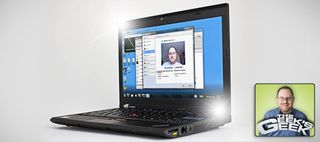5 Reasons Why You Need a New Notebook Now

Last year. That's when my father just finally gave up on pfs: Write, the same word-processing software he'd been using since 1986. If his old printer hadn't broken or if the DOS-based program worked with a modern inkjet printer, he'd still be typing away in a mouse-less, single-font program from the Cold War era, because it seemed good enough to meet his basic document-editing needs.
Unfortunately, far too many consumers are following my father's example, sticking with three-, four-, or even five-year-old notebooks because they don't see a compelling reason to upgrade. As a result of this trend, research firm Gartner projected a tepid 3.8-percent growth rate in 2011 PC sales (hey, at least they're growing).
Gartner research director Ranjit Atwal attributes the decline in sales both to younger consumers who prefer to buy tablets and smartphones and older consumers content with their current PCs. "For older buyers, today's PCs are not a particularly compelling product, so they continue to extend lifetimes, as PC shops and IT departments repair rather than replace these systems," he said in a press release.
If you're one of those folks who feel content with a senile system, I'm here to tell you that you're wrong. Here are five reasons why you need a new notebook this year.
- Longer Battery Life: Unless you replaced the battery, your three- to five-year-old notebook can hold only a fraction of its original charge. Even worse, it probably didn't last that long in the first place, as mainstream notebooks from 2008 and earlier offered poor endurance.
Today, you can purchase a notebook that gets more than 6 hours of endurance, such as the HP Pavilion dm1z, for less than $500. Or you can get an incredibly long-lasting business system such as the Lenovo ThinkPad X220 that can go for over 20 hours on a charge! Think you don't need to stay unplugged that long? Think again, because even in the office or the living room, you should never be chained to an outlet.
- Lighter Weight: A few years ago, most ultraportable notebooks were too expensive for the average consumer. That 15-inch clunker from 2007 feels more like a desktop than a laptop when compared to svelte systems such as the Apple MacBook Air, Samsung 9 Series, or any of the Ultrabooks(a new class of uber-thin laptops Intel has been pushing).
With an 11- to 14-inch notebook that weighs less than 5 pounds—preferably less than 4 pounds—you can completely change your mobile life and really take your PC everywhere you go. If you need a desktop-like experience, you're better off buying an external monitor ($150 gets you a 21-inch display) to plug in when you're at home.
- SSDs/Faster Storage: There's nothing quite like the speed of an solid state drive. The faster boot times, lightning-quick app opens, and improved responsiveness make a computer with an SSD seem decades ahead of one without.
Back in 2007-2008, solid state storage was in its infancy. Even if you could afford a notebook with SSD, the speeds weren't always impressive. The price of moving to SSD is still high, but many more systems come with SSD options now. Better still, for around $200, you can upgrade any modern notebook to SSD yourself. And laptops with Intel's 2nd Generation Core Series CPUs and chipsets support SATA 6Gb/s SSDs, which are twice as fast as the previous generation of drives!
Stay in the know with Laptop Mag
Get our in-depth reviews, helpful tips, great deals, and the biggest news stories delivered to your inbox.
Intelligent Graphics Switching: If your 2008-era notebook has discrete graphics, it gulps power like a teenager scarfing down slurpees. In 2010, Nvidia released its Optimus technology, which automatically switches between discrete and integrated modes to give you the best combination of performance and power efficiency. With Optimus, even a gaming-oriented notebook such as the Alienware M11x can last more than 8 hours on a charge. AMD also recently released its own automatic graphics switching technology, though its implementation lacks the fine control of Optimus' technology.
- USB 3.0: Even in 2011, many notebooks still don't have USB 3.0 ports. However, you'll need SuperSpeed USB to attach the current generation of high-performance backup drives. With transfer rates more than double those of USB 2.0, USB 3.0 drives such as the Iomega eGo are a must-buy for anyone with lots of media files.
So even if your old-school computer from 2008 or before lets you perform the basics, it's time to up your mobile game with a new notebook. You'll experience a new world of power and functionality you might not even know you needed.
